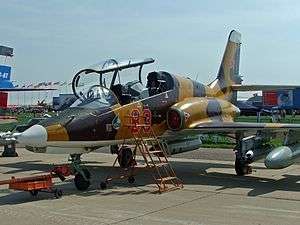Mikoyan MiG-AT
| MiG-AT | |
|---|---|
 | |
| MiG-AT "81" and "83" | |
| Role | Advanced trainer / light attack |
| Manufacturer | Mikoyan |
| First flight | March 21, 1996[1] |
| Status | Cancelled |
| Number built | 2 |
|
| |
The Mikoyan MiG-AT is a Russian trainer aircraft that first flew in 1996, designed to replace Aero L-29 and L-39 for the Russian Air Force. The MiG-AT is the first joint aircraft development programme between Russia and France and the first military collaborative project between Russia and the West to reach first flight.[1] Besides the Russian Air Force and Air Defense Forces, Mikoyan sought to export the trainer to India, South Africa, Greece, France and Commonwealth of Independent States such as Kazakhstan and Uzbekistan.[1][2]
Design
The MiG-AT is more conventional than the competing Yak-130. It has a low-set, straight wing, engines mounted on either side of the fuselage and a mid-mounted tail. Two prototypes have been built. The first flight took place between 16 and 22 March 1996 in Zhukovsky and lasted seven minutes.

Flight tests Equipped the AL-55I engine are succeed in 2008.[3]
The software suite of the MiG-AT allowed the aircraft to adopt the characteristics of third- and fourth-generation jet fighters.[1]
In March 2002, Commander-in-Chief Vladimir Mikhailov said that the Yak-130 and the MiG-AT had been chosen as the Russian Air Force's new trainers.[4][5] The Yak-130, however, was said to be superior as it could serve the dual role of a trainer and combat jet.[6] Despite that, on 10 April 2002, it was announced that Yak-130 had been chosen as the winner of the tender for trainer aircraft for basic and advanced pilot training, beating the MiG-AT.[7] By then, the two prototypes had amassed 750 flights.[6]
Specifications
Data from Jane's All The World's Aircraft 2003–2004[8]
General characteristics
- Crew: 2
- Length: 12.01 m (39 ft 5 in)
- Wingspan: 10.16 m (33 ft 4 in)
- Height: 4.42 m (14 ft 6 in)
- Wing area: 17.67 m2 (190.2 sq ft)
- Aspect ratio: 5.7:1
- Gross weight: 4,610 kg (10,163 lb) (training)
- Max takeoff weight: 7,800 kg (17,196 lb) (combat)
- Fuel capacity: 2,390 L (632 US Gallons)
- Powerplant: 2 × SNECMA Turbomeca Larzac 04-R-20 turbofan, 14.12 kN (3,170 lbf) thrust each
- Powerplant: 2 × NPO Saturn AL-55 turbofan, 17.27 kN (3,880 lbf) thrust each
- Powerplant: 2 × RD-1700 turbofan, 16.67 kN (3,750 lbf) thrust each
Performance
- Maximum speed: 1,000 km/h (621 mph; 540 kn) at 2,500 m (8,200 ft)
- Range: 1,200 km (746 mi; 648 nmi)
- Ferry range: 2,000 km (1,243 mi; 1,080 nmi)
- Service ceiling: 14,000 m (45,932 ft)
- g limits: +8.0, -2.0
- Rate of climb: 81.7 m/s (16,080 ft/min)
Armament
- Hardpoints: 7 with a capacity of 2,000 kg (4,400 lb) total,
See also
- Aircraft of comparable role, configuration and era
- EADS Mako/HEAT
- Hongdu L-15
- Sukhoi S-54 - although single-engined it was entered into the same UTS (new generation jet trainer) design competition
- Yakovlev Yak-130 - selected UTS design
References
- 1 2 3 4 Taverna, Michael (May 1, 1996). "Franco-Russian trainer hits sales trail". Interavia Business & Technology. Aerospace Media Publishing. ISSN 1423-3215. Retrieved August 22, 2015 – via HighBeam Research. (subscription required (help)).
- ↑ Baumgardner, Neil (19 June 2001). "Russia's MiG Looks To Greece As Launch Customer For MiG-AT Trainer". Defense Daily. Retrieved 22 August 2015 – via HighBeam Research. (subscription required (help)).
- ↑ Flight tests of the AL-55I engine developed by NPO Saturn on the MiG-AT training aircraft are successfully going on
- ↑ Butowski, Piotr (1 May 2002). "Russian military trainer strategy falls into place; the selection of the Yak-130 marks an important step towards replacing the country's aging fleet of L-39Cs. Things are moving in the simulator business, too". Interavia Business & Technology. Aerospace Media Publishing. ISSN 1423-3215. Retrieved 22 August 2015 – via HighBeam Research. (subscription required (help)).
- ↑ Pronina, Lyuba (1 April 2002). "MiG, Yak to Split Training Craft Deal". The Moscow Times. Retrieved 22 August 2015 – via HighBeam Research. (subscription required (help)).
- 1 2 Pronina, Lyuba (8 April 2002). "French Tout MiG-AT Partnership". The Moscow Times. Retrieved 22 August 2015 – via HighBeam Research. (subscription required (help)).
- ↑ "Yakovlev Yak-130 (Russian Federation), Aircraft – Fixed-wing – Civil/military". Jane's All the World's Aircraft. 20 July 2010.
- ↑ Jackson 2003, pp. 387–388.
- Jackson, Paul. Jane's All The World's Aircraft 2003–2004. Coulsdon, UK: Jane's Information Group, 2003. ISBN 0-7106-2537-5.
The initial version of this article was based on material from aviation.ru. It has been released under the GFDL by the copyright holder.
External links
| Wikimedia Commons has media related to Mikoyan-Gurevich MiG-AT. |